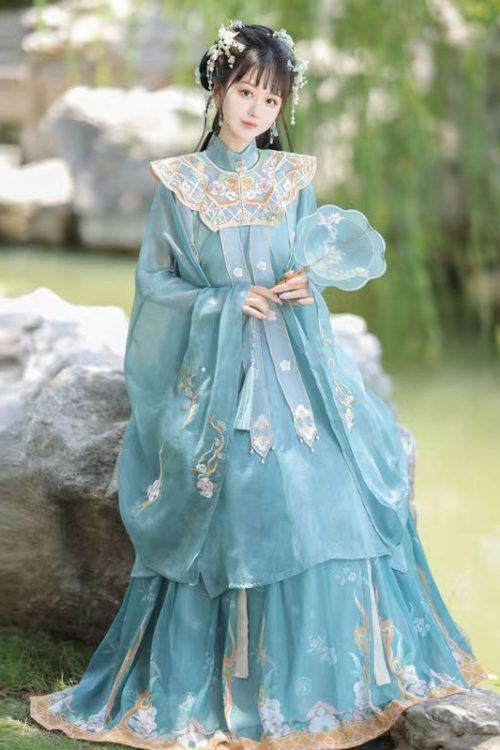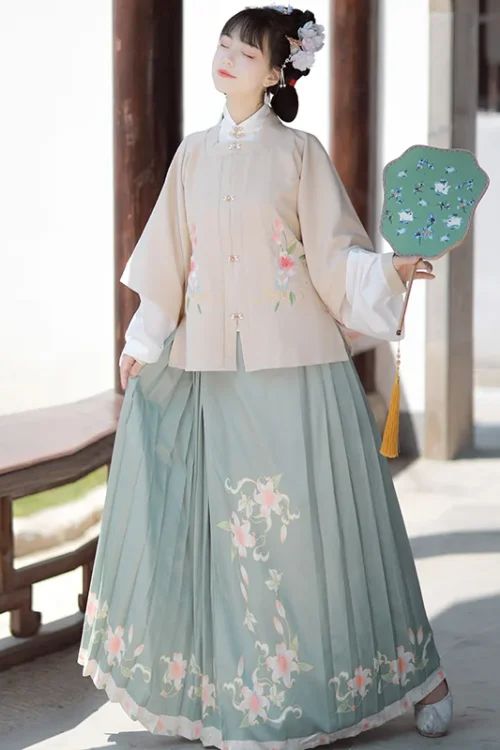The Enduring Legacy of 明代汉服 in Contemporary Chinese Fashion
The Ming Dynasty (1368-1644) witnessed a flourishing of Chinese culture, including the development of exquisite garments known as Hanfu. These traditional robes, characterized by their flowing lines, vibrant colors, and intricate embroidery, have left an enduring legacy on modern Chinese fashion.

Resurgence of Traditional Aesthetics
Hanfu’s influence is evident in the resurgence of traditional Chinese aesthetics in contemporary fashion. Designers are incorporating elements of Hanfu into their collections, such as the use of silk fabrics, wide sleeves, and traditional motifs. This trend reflects a growing appreciation for China’s rich cultural heritage and a desire to connect with the past.
Blending Traditional and Modern Elements
Moreover, Hanfu has inspired the creation of new fashion styles that blend traditional and modern elements. Designers are experimenting with innovative silhouettes and fabrics while incorporating Hanfu’s signature details. This fusion of old and new has resulted in a unique and vibrant fashion aesthetic that celebrates Chinese culture while embracing contemporary trends.
Hanfu in Everyday Wear
The influence of Hanfu extends beyond the realm of high fashion. It has also become popular in everyday wear, particularly among young people. Hanfu enthusiasts often wear traditional robes in public spaces, creating a visible presence of Chinese culture in modern society. This trend has fostered a sense of cultural pride and has helped to raise awareness of Hanfu’s historical significance.
Promoting Cultural Exchange
Furthermore, Hanfu has played a role in promoting cultural exchange. International designers have been drawn to the beauty and craftsmanship of Hanfu, incorporating its elements into their own collections. This cross-cultural pollination has not only enriched the global fashion landscape but has also fostered a greater appreciation for Chinese culture worldwide.
结论
In conclusion, the Ming Dynasty Hanfu has had a profound impact on modern Chinese fashion. Its influence is evident in the resurgence of traditional aesthetics, the creation of innovative fusion styles, and the growing popularity of Hanfu in everyday wear. As a symbol of Chinese cultural heritage, Hanfu continues to inspire designers and fashion enthusiasts alike, bridging the past and present while shaping the future of Chinese fashion.
Hanfu’s Revival: A Symbol of Cultural Identity and National Pride
Reconnecting with Cultural Heritage
The Ming Dynasty (1368-1644) witnessed a flourishing of Chinese culture, including the development of exquisite garments known as Hanfu. These traditional robes, characterized by their flowing lines, vibrant colors, and intricate embroidery, have left an enduring legacy on modern Chinese fashion.

A Surge in Interest
In recent years, there has been a resurgence of interest in Hanfu, driven by a desire to reconnect with China’s rich cultural heritage. This revival has been fueled by the efforts of cultural enthusiasts and fashion designers who have sought to revive the ancient art of Hanfu making.
Vibrant Colors and Cultural Symbolism
One of the most striking aspects of Ming Dynasty Hanfu is its use of color. The robes were often adorned with vibrant hues, such as red, yellow, and green, which symbolized auspiciousness and prosperity. These colors have been incorporated into modern Chinese fashion, adding a touch of traditional elegance to contemporary designs.
Intricate Embroidery and Modern Motifs
Another defining feature of Hanfu is its intricate embroidery. The robes were often decorated with elaborate patterns, including dragons, phoenixes, and flowers. These motifs have been reinterpreted in modern fashion, adding a touch of sophistication and cultural symbolism to clothing.
Influencing Modern Silhouettes
The revival of Hanfu has also influenced the silhouettes of modern Chinese fashion. The flowing lines and loose-fitting nature of Hanfu have inspired designers to create garments that are both comfortable and stylish. This has led to the emergence of new fashion trends, such as the “Hanfu-inspired” dress, which combines traditional elements with modern aesthetics.
A Testament to Cultural Identity
The resurgence of Hanfu is not merely a fashion trend; it is a symbol of cultural identity and national pride. By embracing their traditional garments, Chinese people are reaffirming their connection to their heritage and celebrating the richness of their culture.
Impact on the Fashion Industry
Moreover, the revival of Hanfu has had a positive impact on the Chinese fashion industry. It has encouraged designers to explore their cultural roots and create innovative designs that draw inspiration from the past. This has led to a renewed appreciation for Chinese craftsmanship and a greater understanding of the country’s cultural heritage.
结论
In conclusion, the Ming Dynasty Hanfu has had a profound influence on modern Chinese fashion. Its vibrant colors, intricate embroidery, and flowing silhouettes have been reinterpreted and incorporated into contemporary designs, creating a unique blend of tradition and modernity. The revival of Hanfu is not only a fashion statement but also a testament to the enduring power of Chinese culture and its ability to inspire and shape the present.
The Evolution of 汉服: From Ancient Garments to Modern Style
A Significant Era in Fashion
The Ming Dynasty (1368-1644) marked a significant era in Chinese history, leaving an enduring legacy on various aspects of Chinese culture, including fashion. The Hanfu, the traditional clothing of the Han Chinese, underwent significant developments during this period, shaping its influence on modern Chinese fashion.

Characteristics of Ming Dynasty Hanfu
The Ming Dynasty Hanfu was characterized by its elegant and flowing lines, vibrant colors, and intricate embroidery. The garments were typically made from silk or cotton and featured wide sleeves, long robes, and high waistlines. The use of bright colors, such as red, yellow, and green, symbolized prosperity and auspiciousness.
Distinctive Features: Horse-Hoof Sleeves
One of the most distinctive features of Ming Dynasty Hanfu was the use of horse-hoof sleeves. These sleeves were wide and flared at the cuffs, resembling the hooves of a horse. They added a sense of movement and grace to the garments, making them suitable for both formal and informal occasions.
The Rise of the Ruqun
The Ming Dynasty also saw the rise of the “ruqun,” a type of skirt worn by women. The ruqun was typically made from multiple layers of fabric, creating a voluminous and elegant silhouette. It was often paired with a short jacket or bodice, completing the ensemble.
Modern Influence on Fashion
The influence of Ming Dynasty Hanfu can be seen in various aspects of modern Chinese fashion. Contemporary designers have incorporated elements of Ming Dynasty Hanfu into their collections, such as the use of horse-hoof sleeves, high waistlines, and vibrant colors. These designs have gained popularity both in China and internationally, showcasing the enduring appeal of traditional Chinese aesthetics.
The Role of Hanfu Enthusiasts
Moreover, the revival of Hanfu as a cultural symbol has contributed to the growing interest in Ming Dynasty fashion. Hanfu enthusiasts have played a significant role in preserving and promoting traditional Chinese clothing, organizing events and workshops to educate the public about its history and significance.
结论
The influence of Ming Dynasty Hanfu on modern Chinese fashion is a testament to the enduring power of cultural heritage. By incorporating elements of traditional garments into contemporary designs, fashion designers are not only paying homage to the past but also creating a unique and vibrant expression of Chinese identity. As the appreciation for Hanfu continues to grow, it is likely that its influence on Chinese fashion will continue to evolve and inspire future generations.
